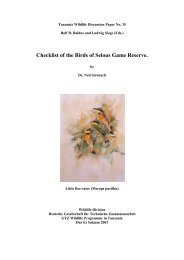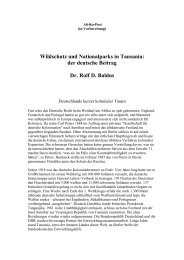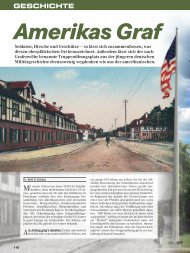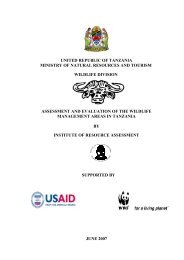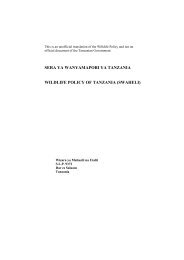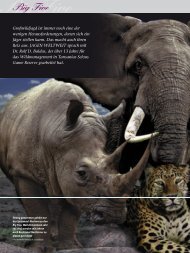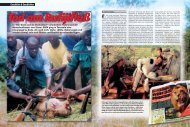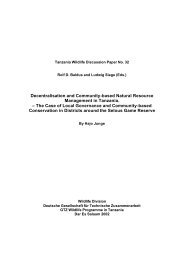African Indaba Articles - wildlife-baldus.com
African Indaba Articles - wildlife-baldus.com
African Indaba Articles - wildlife-baldus.com
You also want an ePaper? Increase the reach of your titles
YUMPU automatically turns print PDFs into web optimized ePapers that Google loves.
owe it to ourselves. We owe it to conservation, because sustainable trophy hunting is an indispensableconservation and <strong>wildlife</strong> management tool in the 21 st century.”Damm’s presentation was reviewed by Don Causey, president of The Hunting Report from an Americanpoint of view and by Dr Karlheinz Betz, Editor-in-Chief of Wild & Hund from a European angle. Both reviewsalso form part of this issue of <strong>African</strong> <strong>Indaba</strong>. Be sure to read these <strong>com</strong>ments on pages 11 and 12.Readers will also be interested that “The Hunting Report“also initiated a web-forum in the meantime on itswebsite www.huntingreport.<strong>com</strong> to enable a broad section of its international readers to participate in thediscussion of the topic, in particular in connection with the <strong>African</strong> buffalo trophy scoring methods, whichwere heavily criticized as leading towards the unsustainable removal of pre-breeding and breeding bulls fromthe populations.Dr. Betz’ review in German is printed in this issue (page 12) in the original German version. His mainpoints are summed up as follows: He concurs that all involved in hunting need to be pre-occupied with theimage of hunting. Betz mentions that trophy hunting and hunting trophies gained public notice at the 1937International Hunting Exhibition in Berlin, which served to bring international game biologists together for thefirst time.He agrees with Damm that hunters need to be revise trophy scoring methods which lead to the hunting ofyoung (pre-breeding or breeding) trophy animals. He suggests that this could be achieved by scrutinizing thedifferent trophy scoring methods with respect to the relevance or absence of age factors. He also suggeststhat subjective aesthetic criteria like in the CIC cervidae formulas be replaced by “age points”, respectivelypenalty points be introduced, if a trophy animal has been taken before the species-specific target age.According to Dr Betz opinion, the changing of formulas and trophy scoring methods does have a negativeconnotation. Changes may <strong>com</strong>plicate or even prevent the <strong>com</strong>parison of trophies measured according to“old” standards with those measured according to “new” standards. This would be, however, according to DrBetz, negligible in view of the importance of the general relevance of biologically correct trophy scoringmethods.In two interfacing speeches, Gray Thornton, Professional Member of The Boone & Crockett Club (USA),explained the Boone & Crockett Club Philosophy for Hunting Trophies and Peter Flack, Chairman ofRowland Ward’s went into the origin and purpose of Rowland Ward’s Book of Trophy Records.The second key-note presentation of the day was given by Gray Thornton in his capacity as ExecutiveDirector of the Dallas Safari Club and the Dallas Ecological Foundation. Thornton’s passionate speech,which kept the listeners spell bound, explored the “Essence of Hunting”.Thornton first analyzed the question of “Why We Hunt” and how this may affect our hunting attitudes. Heprovocatively asked whether the trophy recording systems are an Achilles Heel of huntingIn continuation, Thornton tried to provide answers to the question “what determines a successful huntingexperience” and led the audience through the six stages of a hunter citing personal experiences from hisdecades of hunting experiences.Of interest in the context of the workshop was the “Trophy Stage”, where according to Thornton huntingsuccess is judged by quality, not quantity, and record books may be<strong>com</strong>e a means to define such success.Yet, according to Thornton, the objective for all hunters should be the “Sportsman Stage” and the “Give BackStage”. The first one measures success by the quality of a total outdoor experience, and not by the momentwhen a trigger is pulled or the trophy obtained. The latter one brings <strong>wildlife</strong> conservation and habitatprotection into special focus, just as the sharing and passing of the values and traditions of hunting to theyoung hunters and the people around us.You can read the full text of Gray Thornton’s presentation on page 14 of this issue.The concluding hour of the first day’s meeting saw animated discussions and contributions from the floorcovering a wide spectrum of fields and, as may be imagined, sometimes with contrasting opinions.Representatives of European, Asian, <strong>African</strong> and American Hunting Associations made their views known,as well as individual participants.During the second day, Dr. Rolf Baldus, President of the CIC Tropical Game Commission chaired anotheranimated couple of hours of discussion.Peter Flack, Chairman of Rowland Ward, said with respect to public perception of hunting that „everyorganization has an image – if the organization does not manage it, somebody else will do it and this139



